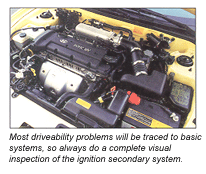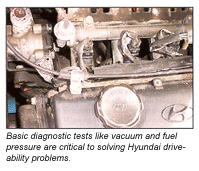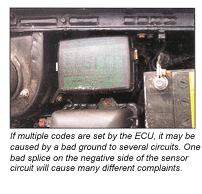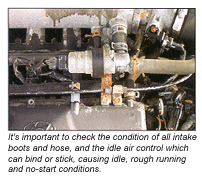Take it for a Spin
Like any other vehicle, most driveability problems will be traced to basic systems. Even if you’re armed with good information, it’s important to road-test the car and duplicate the complaint before attempting any repairs. This is also the time to make note of any other problems you may have noticed that the customer failed to mention. Don’t overlook the little items, such as lubricating a squeaky door or tightening the armrest. Customers expect us to fix their cars, but it’s the little extras that will make your shop special.
If you’re lucky, you’ll get the car in and the problem will be obvious. Maybe it’s a dead miss or an idle problem. Unless the customer complaint includes a cold idle problem, I recommend taking the time to test-drive the car. I know that if I can duplicate the problem, I can be sure the repair was successful during the final road test. And even if your customer has provided details about the problem, it’s never a good idea to assume anything. I’m sure that I’m not the only one who has wasted time looking at a no-power complaint, only to find out the clutch was slipping once I finally road-tested the car.
In this edition of Foreign Affairs, we’ll take a look at some of the problems you are likely to see when faced with diagnosing a driveability complaint on a Hyundai.
Talk it Out
 Diagnosing a driveability problem starts with the customer interview. When you are able to obtain the proper details about the vehicle’s symptoms, you will be able to diagnose the source of the problem more efficiently. Clues provided by the customer, such as “vehicle starts, but runs rough until warm; worse when wet,” is invaluable information to get you started on your diagnostic routine and lead you to a successful repair.
Diagnosing a driveability problem starts with the customer interview. When you are able to obtain the proper details about the vehicle’s symptoms, you will be able to diagnose the source of the problem more efficiently. Clues provided by the customer, such as “vehicle starts, but runs rough until warm; worse when wet,” is invaluable information to get you started on your diagnostic routine and lead you to a successful repair.
Hyundai No Start Tips
Hyundai has had its share of no-power complaints. Most of these complaints are on older models with high mileage. Oftentimes, these problems will lead to a plugged catalytic converter. It’s not unusual that the first symptom the customer gets with a plugged converter is a no-start problem. Diagnosing this problem on a Hyundai can be a little trickier than on other nameplates. Normally, you would expect a plugged exhaust to always be plugged. Sure, they will get worse as they heat up, but the problem is usually easy to pick up on a road test. But the converter on a Hyundai will fail and the catalyst will break up into pieces, caused by the effect of heat and the exhaust gases, and will fill the outlet of the converter shell and block the exhaust almost completely.
 The first one we saw was a diagnostic challenge. If you suspect a problem with the catalytic converter, don’t forget that it’s right under the exhaust manifold. Remove the O2 sensor to access pre-converter exhaust gases to either test the pressure or provide a path for the gases. If you get one of these cars in and detect that it has wet spark plugs with good spark, yet it won’t fire even after the cylinders have been dried out and the new plugs have been installed, the next thing I would check is the exhaust.
The first one we saw was a diagnostic challenge. If you suspect a problem with the catalytic converter, don’t forget that it’s right under the exhaust manifold. Remove the O2 sensor to access pre-converter exhaust gases to either test the pressure or provide a path for the gases. If you get one of these cars in and detect that it has wet spark plugs with good spark, yet it won’t fire even after the cylinders have been dried out and the new plugs have been installed, the next thing I would check is the exhaust.
Be sure to also check the motor oil, since it likely needs to be changed. It may have to be done as part of the drying-out process. Depending on how long the customer tried to start the car, the crankcase may have quarts of gas mixed in with the oil. Even if the crankcase isn’t overfilled, always recommend the oil change.
More Quick Checks
Other low-power complaints may be traced to misadjusted timing belts and/or tensioners. Without getting into timing belt replacement, it’s important to note that some techs are not properly adjusting the belts. They improperly preload the tensioner, and the resulting loose belts are jumping and upsetting the cam timing.
Don’t forget to tee in your vacuum gauge to get an idea of what the intake manifold is seeing. One simple hook up will let you know if the engine is passing air. 
Any problems with exhaust flow or valve timing will certainly be evident. If you aren’t using a vacuum gauge as part of your driveability routine, you should give it a try. As with any tool, once you know what you’re looking for, the problems are easy to pick up. As a rule, three or four inches of vacuum are what you’re looking for when cranking with a strong battery and closed throttle.
If the car runs, you’ll be looking for something in the high teens or low 20s at idle. Open the throttle, and vacuum will drop and then recover as air passes through the intake. No vacuum cranking could either point to the valve timing or a plugged cat. On Hyundais, I would remove the O2 sensor and retest. Low vacuum at idle, combined with a low-power complaint, would have me thinking that valve timing was the problem or, depending on the model, base ignition timing. If there is a slow recovery of vacuum after opening the throttle, I’d be looking for a restricted exhaust that won’t let air pass through the engine.
DTCs
Now back to the road test. Say that you’ve driven the car and can’t duplicate the problem. The next step is to access the on-board diagnostic system. Hyundai has made it easy for us get codes, although it is a little different than what we may be used to doing. Using an analog voltmeter connected to the data link connector in the fuse box, we can count the sweeps and length of time on the meter to give us long and short sweeps. The long sweeps are 10s and the short sweeps are ones. Two long sweeps, followed by one short sweep, is a code 21. On a 1992 Excel, for example, that would be the coolant temperature sensor.
 On the later model cars equipped with OBD II, you’ll need a scanner to access codes, as well as a strong data stream that will make the diagnostic process easier and faster. But like the earlier cars, don’t be too quick to replace components. I hope that your shop has made the wise investment in a scan tool with Asian software, which can be a big help with the diagnostic process on Hyundais. In addition to retrieving codes, you’ll find the data stream to be thorough and quick, allowing you to look at what the computer is seeing.
On the later model cars equipped with OBD II, you’ll need a scanner to access codes, as well as a strong data stream that will make the diagnostic process easier and faster. But like the earlier cars, don’t be too quick to replace components. I hope that your shop has made the wise investment in a scan tool with Asian software, which can be a big help with the diagnostic process on Hyundais. In addition to retrieving codes, you’ll find the data stream to be thorough and quick, allowing you to look at what the computer is seeing.
By hooking up the scanner on this car that we’ve been road testing, we can retrieve any codes that may have been stored within a couple of minutes. If a code is set, it could be a big help in pinpointing the problem as long as it’s related to the complaint. If the code has nothing to do with the symptom, make a note of it, but don’t let it send you down the wrong path. There is no point in checking the mass air flow sensor on a car that runs well because a code has been set. It could have been set when the air filter was checked and the sensor was left unplugged while the car was started. Write down the codes and clear them. On the earlier cars, if you’re not using a scanner, you’ll have to disconnect the negative battery cable to clear the codes.
Pattern Failures
Since changing over to fuel injection, Hyundai has earned a good reputation for driveability and its vehicles don’t have many pattern failures. The most common and frustrating failure covers a poor splice in the negative side of the sensor circuit. Because this circuit has an effect on all the sensors, this problem will cause many different complaints. Since the problem is at the splice, it may affect the coolant temperature sensor one time and set that code. The next time it runs bad, it may be the air flow meter ground that goes open and sets that code.
If you’re working on a car that seems to have a lot of codes and intermittent problems, think about the ground side of the sensors. On some cars, only one leg of the splice is bad and it affects just one of the sensor circuits.
We once worked on an Excel that would start and stall once in a while. The MIL lamp would come and go, but would always set a coolant temperature sensor code. Finally, the connection got bad enough that we were able to see the problem. With a voltmeter hooked to the positive side of the sensor while driving, we would see the full reference voltage. Since the sensor resistance was correct and the connection was good, we simply added an extra ground for the temperature sensor and that took care of the problem.
ECU
Hyundais also have more problems with ECUs than we are used to seeing on other vehicles. I’ve heard that many of the problems are the result of low-quality rebuilt alternators and the resulting overcharging that takes place. I’m sure that some of these problems are also the result of careless jump-starting. Whatever the reason, keep it in mind that they fail.
Most of the time, the bad ECU will result in a no-start complaint. But some of them will present other symptoms. Of course, you wouldn’t declare a computer bad without confirming the power and ground circuits to the unit. After calling a dealer to check on the price of the ECU, you will be looking for another source. Depending on the year and mileage of the car, using a used unit or sending the unit out to be rebuilt are both good options we’ve used with success.
When we checked the codes on the car we’ve been road testing (that has no symptoms), there were no codes present. Before you return the car to the customer, asking him or her to drive it until the symptoms are more evident, double-check the ignition secondary system and don’t forget to look at the spark plugs.
Go With The Air Flow
Other problems you may find on Hyundais are no different than the things you’ll see on other nameplates that share the same systems. Hyundai has used both mechanical and hot-wire air flow sensors. The door on the mechanical unit, which can cause problems with binding and sticking, should be no problem to diagnose. Simply operate the door while you’re replacing the air filter to check for nice smooth operation. The hot-wire sensor has proven to be a reliable piece with few problems.
By far, the most common problem you’ll see with the air intake system is the hose that connects the intake manifold to the air sensor. Cracked intake hoses are a common problem with many brands, but they continue to be overlooked by some techs. This problem will result in a big hesitation when the vehicle is accelerated hard from a slow speed or standing start. When the engine strains against the motor mounts, the crack in the hose opens, allowing unmeasured air into the engine. The resulting lean mixture makes the engine stumble, closing the opening and starting the whole procedure all over again. If you are working on a vehicle that stumbles upon acceleration, give this hose a good inspection. They usually crack on the bottom, so it may be necessary to pull it off the air filter box and bend it to find the crack.
For The Record
We know that Hyundais appeal to commuters and young people, who are not the kind of drivers who keep a close eye on the maintenance schedule. I’m not a fan of selling a “tune up” in an attempt to repair a driveability problem. But if you remove a spark plug and the center electrode is eroded down to the insulator, the car is telling you it needs to be serviced. There is no point in looking for driveability problems until this service is performed.
While the service is being done, be sure to recall the original complaint. It is more efficient to replace the bad wires, cap and rotor while doing the service, than it is to have the customer return after spending a couple hundred dollars, only to still have the same symptoms.
Remember: Don’t sell them stuff they don’t need, but don’t overlook needed items.
Note: When you’re working on a Hyundai, it is extremely important to remember that fault codes are circuit specific, rather than component specific. In this case, the code is a good indication that the ECU is not seeing information from the coolant temperature sensor that it expects to see. It’s not indicating that the sensor is at fault.
|
Did You Know…
Hyundai sold its first car, the subcompact Excel model, in the U.S. in 1986. At the time, few Americans had ever heard of Hyundai or its products. Since that time, Hyundai has expanded and upgraded its product line in the U.S. and now accounts for more than 2% of the U.S. auto market. |


